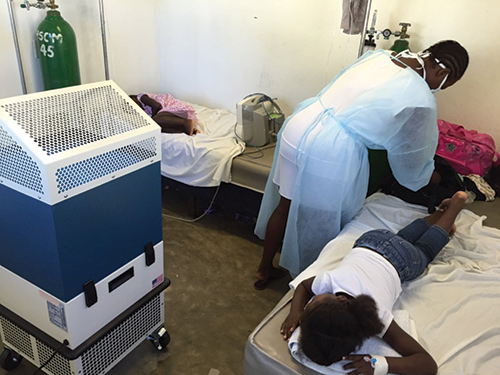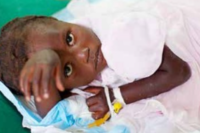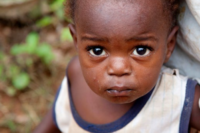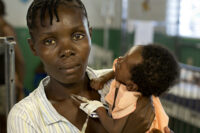
Typical gray-white pseudomembrane in the throat of a patient with diphtheria.
A four-year-old girl from a small town in the north of Haiti was critically ill. Happy and playful just the day before, she was now infected with a deadly bacterium and couldn’t breathe. She gasped for air but nothing flowed. The fear in her eyes was crystal clear to the Pediatricians caring for her. They were doing everything they could to help her breathe while the Surgeons prepared the operating room to perform a life-saving airway procedure called a cricothyroidotomy. This procedure would bypass the worsening obstruction in her throat by placing a breathing tube directly into her trachea through her neck. They were running out of time.
Just 12 hours earlier, it was a typical warm February evening in the Pediatric ward at Hôpital Sacré Coeur. The ward was full of Haitian children and infants with common pediatric illnesses like pneumonia, diarrhea, and malnutrition. The Pediatrician on-call, Dr. Exavier, was settling the children in for the evening when he was notified about two young girls with upper respiratory symptoms, including a severe sore throat and neck swelling. On examination, he noted a gray-white membrane in the throats of the six and four-year-old sisters. Dr. Exavier recognized this right away as the hallmark “pseudomembrane” of diphtheria, a deadly respiratory illness caused by the bacteria Corynebacterium diphtheria. Patients infected with diphtheria are in danger of several fatal complications including airway obstruction when these pseudomembranes occlude their trachea. To make matters worse, Dr. Exavier received word that two more children from the same family were en route to the hospital with similar symptoms.
While diphtheria has been nearly eradicated in the US and other developed countries due to comprehensive immunizations, the disease remains a sad fact of life in developing countries like Haiti. Diphtheria is highly contagious and carries a mortality rate of 10 percent, but is often higher in young children and older adults.
Diphtheria can be a challenge to manage in even the most resource-rich medical facilities. Aside from the life-saving surgical intervention a very scarce antitoxin is required treatment. Fortunately Dr. Exavier and his Pediatric and Surgical colleagues at Hôpital Sacré Coeur were not on their own. Over the past five years, a group of US-based Pediatric specialists have been working closely with the Pediatricians at Hôpital Sacré Coeur with the goal of improving the medical care provided to children in Northern Haiti. Through partnership, mentorship and multidisciplinary support, the Haitian staff and American team of physicians, nurses, and respiratory therapists have built what is arguably the top Pediatric medical care team in Northern Haiti. Implementing sustainable programs in direct patient care such as breathing support for premature infants and integrated doctor/nurse care plans as well as indirect patient care through telemedicine, the team has saved and improved the lives of many children over the past five years.

A nurse wearing personal protective equipment cares
for two children with Diphtheria at Hôpital Sacré Coeur. A HEPA filtration unit can be seen in the background.
Thanks to effective communication and coordination on many levels, plans were put in place to secure this essential therapy in time to give the patients a fighting chance. The next morning, diphtheria antitoxin was shipped from the CDC station at Miami International Airport, though Port-au-Prince to Milot, where it arrived by late afternoon. For the four year old girl from a small town in the north of Haiti, the antitoxin would arrive too late. She died on the operating room table before a surgical airway could even be attempted. However, her siblings were more fortunate — their illness was milder and they responded well to the various therapies provided by the Pediatric team. They were discharged home in good health the following week Perhaps even more important, the diphtheria outbreak did not spread beyond these four cases. No secondary cases occurred at the hospital or in the community where the family lives, a tribute to the quick and competent response of the Hôpital Sacré Coeur Pediatric team.
Robert J. Freishtat, MD, MPH is Associate Chief for Academic Affairs, Division of Emergency Medicine, Children’s National Health System and Associate Professor of Pediatrics, Emergency Medicine, and Integrative Systems Biology at George Washington University School of Medicine and Health Sciences.
Michael F. Canarie, MD is pediatrician at Baystate Health in Springfield, MA. and specializes in Pediatric Critical Care Medicine. He is also an assistant professor at Tufts Medical Center.









